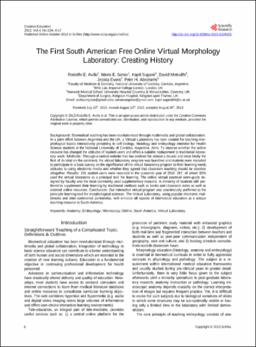| dc.contributor.author | Samar, María Elena | |
| dc.contributor.author | Metcalfe, David | |
| dc.contributor.author | Evans, Jessica | |
| dc.contributor.author | Abrahams, Peter H. | |
| dc.contributor.author | Ávila, Rodolfo Esteban | |
| dc.contributor.author | Sugand, Kapil | |
| dc.date.accessioned | 2024-02-08T15:09:09Z | |
| dc.date.available | 2024-02-08T15:09:09Z | |
| dc.date.issued | 2013 | |
| dc.identifier.issn | 2151-4771 | |
| dc.identifier.uri | http://hdl.handle.net/11086/550454 | |
| dc.description.abstract | Biomedical teaching has been revolutionized through multimedia and global collaboration. In a joint effort between Argentina and the UK, a Virtual Laboratory has been created for teaching mor- phological topics interactively pertaining to cell biology, histology and embryology intended for Health Science students at the National University of Cordoba, Argentina. Aim: To observe whether the online resource has changed the attitudes of student-users and offers a suitable replacement to traditional labora- tory work. Methods: Through a central website that has evolved for almost a decade and most likely the first of its kind on the continent, the virtual laboratory program was launched and students were recruited to participate in a basic survey on the significance of the virtual laboratory program to their learning needs, attitudes to using electronic media and whether they agreed that classroom teaching should be obsolete altogether. Results: 291 student-users were recruited in the academic year of 2010. 267, of whom 92% used the virtual laboratory as a principal tool for learning. The online virtual practical work-guide de- signed by faculty was the most commonly used supplementary resource. A minority of students still pre- ferred to supplement their learning by traditional methods such as books and classroom notes as well as external online resources. Conclusion: Our interactive virtual program was unanimously preferred as the principle learning tool for morphological sciences. The Virtual Laboratory, using popular electronic mul- timedia and inter-continental partnership, will enhance all aspects of biomedical education as a unique teaching resource in South America. | es |
| dc.description.uri | http://www.scirp.org/journal/PaperInformation.aspx?PaperID=36717 | |
| dc.format.medium | Electrónico y/o Digital | |
| dc.language.iso | eng | es |
| dc.publisher | Scientific Research | es |
| dc.rights | Attribution-NonCommercial-ShareAlike 4.0 International | * |
| dc.rights.uri | http://creativecommons.org/licenses/by-nc-sa/4.0/ | * |
| dc.subject | Anatomy | es |
| dc.subject | Embriology | es |
| dc.subject | Microscopy | es |
| dc.subject | Online | es |
| dc.subject | South America | es |
| dc.subject | Virtual laboratory | es |
| dc.title | The first South American free online virtual morphology laboratory: creating history | es |
| dc.type | article | es |
| dc.description.version | info:eu-repo/semantics/publishedVersion | es |
| dc.description.fil | Fil: Ávila, Rodolfo Esteban . Universidad Nacional de Córdoba. Facultad de Odontología; Argentina. | es |
| dc.description.fil | Fil: Samar, María Elena. Universidad Nacional de Córdoba. Facultad de Odontología; Argentina. | es |
| dc.description.fil | Fil: Metcalfe, David. University Hospital Coventry & Warwickshire. Warwick Medical School; United Kingdoom. | es |
| dc.description.fil | Fil: Evans, Jessica. Kingston Hospital. Department of Surgery. Kingston upon Thames; United Kingdoom. | es |
| dc.description.fil | Fil: Abrahams, Peter H. University Hospital Coventry & Warwickshire. Warwick Medical School; United Kingdoom. | es |
| dc.description.fil | Fil: Sugand, Kapil. Imperial College. MSk Lab; United Kingdoom. | es |
| dc.journal.city | Delaware | es |
| dc.journal.country | Estados Unidos | es |
| dc.journal.editorial | Scientific Research Publishing inc. | es |
| dc.journal.number | 10A | es |
| dc.journal.pagination | 6-17 | es |
| dc.journal.referato | Con referato | |
| dc.journal.title | Creative Education | es |
| dc.journal.volume | 4 | es |
| dc.description.field | Otras Ciencias de la Salud | |





